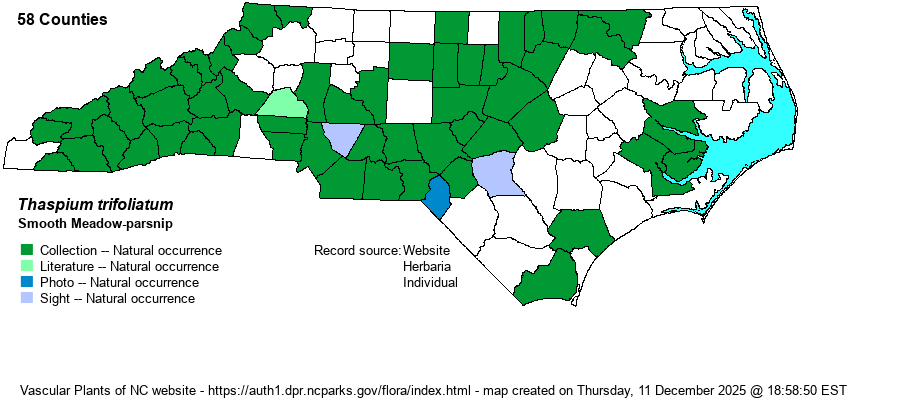| Author | (L.) A. Gray | |
| Distribution | Ranges throughout the Mountains, much of the Piedmont and Sandhills; scattered in the Coastal Plain, mainly in rich soil in the lower Coastal Plain.
This is an Eastern species, ranging from NY and IA south to western FL and eastern TX. | |
| Abundance | Fairly common to frequent in the Mountains; infrequent to fairly common in the Piedmont and Sandhills, though rather rare in the western Piedmont. Very rare to rare in the Coastal Plain, and absent in the far eastern counties. | |
| Habitat | This species grows in mesic forests and small openings, not just in rich soil. It has somewhat a broad range of moisture in which it can grow, though not in xeric places. | |
| Phenology | Blooms in April and May, and fruits from July to August. | |
| Identification | This is a sparingly branched herb growing to about 2 feet tall. It looks nothing like the other two Thaspium species, but closely resembles Zizia aptera, so care must be taken to separate these two. Both species have a simple basal leaf, cordate to orbicular, about 1.5-2 inches across with a serrated margin, and a long petiole of 2-3 inches, at least. Each has stem leaves that are alternate but only once-divided into 3 leaflets, with the leaflets of variable shape (ovate to rounded), 1-2 inches long and somewhat narrower. Each has yellow and flat-topped umbels, as well. In this species, the teeth on the leaflets are rather obtuse as opposed to acute (sharper); the leaflet margins are smooth and strongly hyaline (thin and colorless) margin; the lower portion of the stem is smooth (as opposed to softly pubescent in Zizia); and the rays in each umbel are 4-10, as opposed to 7-15 rays in Zizia. One variety of Thaspium (var. trifoliatum) has maroon flowers, easily separating the two. Note that in Thaspium, the central flower in each umbellet has a distinct stalk, whereas in Zizia species the central flower usually is sessile; you may need a hand lens to see this character. In general, the Thaspium species have a more open umbel, with longer and/or fewer rays, such that each umbellet is widely spaced from others; in Zizia, the umbels are more dense, with more or shorter rays, such that one umbellet nearly touches another. | |
| Taxonomic Comments | There are two varieties in the state, with one (var. trifoliatum) with maroon to purple flowers and the other (var. aureum) having yellow flowers.
| |
| Other Common Name(s) | Purple Meadow-parsnip, Woodland Meadow-parsnip | |
| State Rank | S5 | |
| Global Rank | G5 | |
| State Status | | |
| US Status | | |
| USACE-agcp | | |
| USACE-emp | | |

